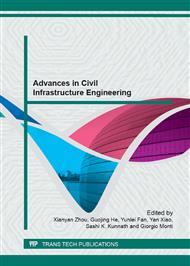p.411
p.417
p.423
p.429
p.434
p.444
p.452
p.456
p.460
Experimental Investigation of Wind Loads on Fish-Shaped Roof Structures
Abstract:
Wind tunnel tests of 1:100 rigid model of fish-shaped roof structures were carried out. The mean, fluctuating (RMS) and peak pressure coefficients, the local shape coefficient distributions on fish-shaped roofs were presented and discussed. It was found that negative pressures (suctions) occurred on the most areas on the roofs, and high negative pressure coefficients occurred on the eaves and cantilevered roof parts. When wind flows blew along the corridors under the roofs, the flows enhanced suctions on the surfaces of the roofs, and the suctions on the lower surface were greater than those on the upper surfaces, positive pressures occurred on that area after superposition of wind actions on the two sides. The roof eaves and regions above the corridors experienced the worst RMS pressure coefficients and the worst minimum pressure coefficients. The distribution characteristics of the worst RMS and minimum pressure coefficients were found to be quite similar to those of the mean pressure coefficients. The results obtained from the experimental investigation are expected to be useful in the wind-resistant design of complex roof structures in typhoon-prone regions.
Info:
Periodical:
Pages:
434-443
Citation:
Online since:
January 2013
Authors:
Price:
Сopyright:
© 2013 Trans Tech Publications Ltd. All Rights Reserved
Share:
Citation:


